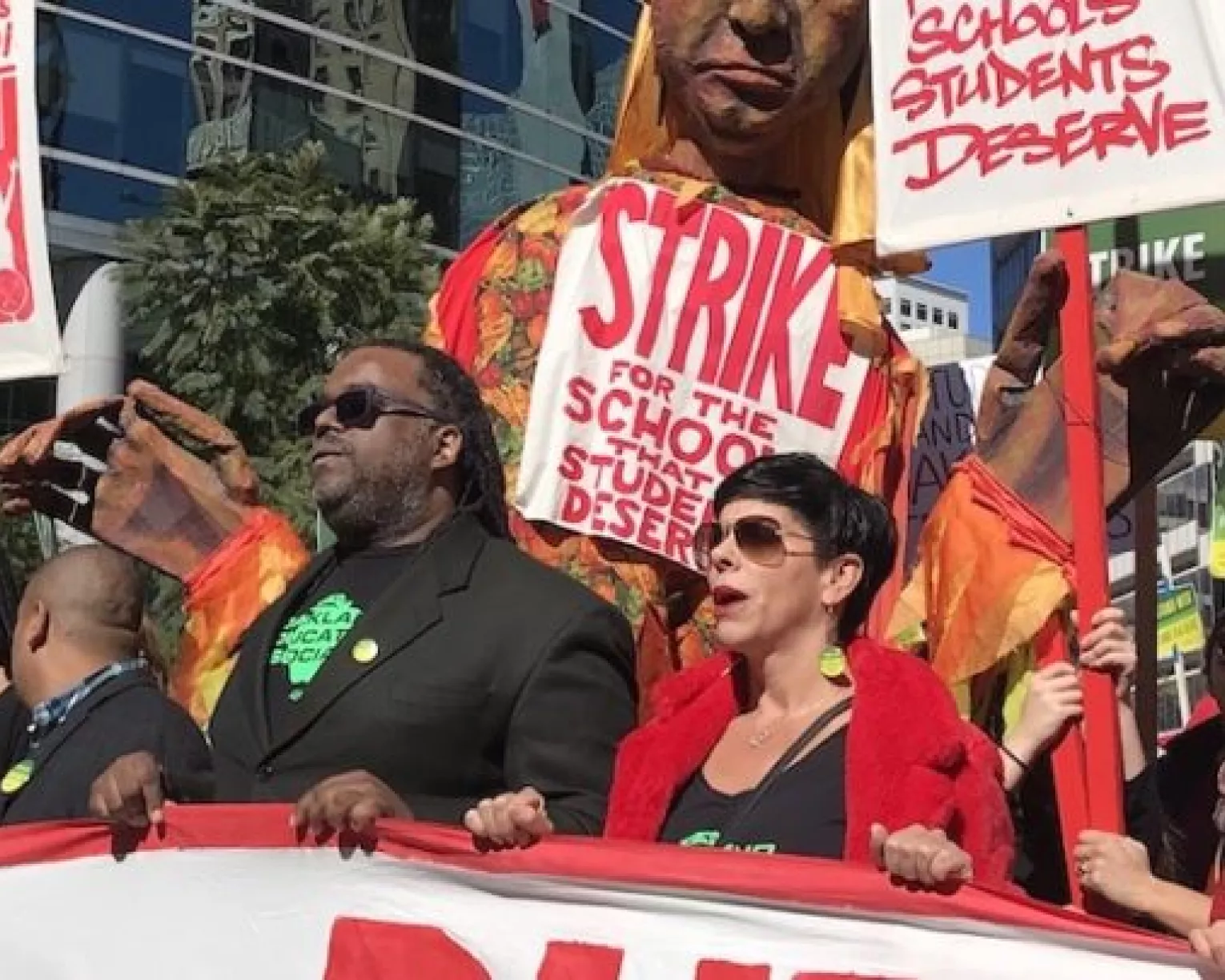Key Takeaways
- Successfully reopening—and staying open and effective for all students—will require collaboration that includes educators and community members.
- Our commitment to racial and social justice must be in the forefront at every stage of planning and implementation.
As states and communities turn their attention to in-person instruction and how to prepare for the predicted subsequent waves of COVID-19, amplifying the voices and expertise of educators to creatively meet these challenges has never been more important. Communities face fundamental choices that call for bold thinking and advocacy to shape what schools should look like for all students.
Whether or not your association bargains collectively, the association must lead in discussions around returning to in-person instruction. Successfully reopening schools, colleges, and universities—and keeping them open and effective for all students—will require collaboration that includes the voice of educators and community members. This is a time for collective decision-making and solutions, not top-down directives by school districts, college and university administrators, or state or local officials. Where education employees have the ability to bargain collectively over the wide range of employment terms and conditions affected by the COVID-19 pandemic, collective bargaining of course must form the basis of labor-management engagement.
Where education employees lack the right to collectively bargain or where collective bargaining is too limited in scope to address the myriad issues related to COVID-19, other forms of collaboration should be used.
Take time at the outset to put structures in place to ensure that plans are informed by the expertise and creativity of all educators, as well as by the views of the broader school community. Ensure that when conversations involve educators, they include, as appropriate to the institution, all relevant categories of employees, including teachers, substitutes, professors, contingent faculty, graduate assistants, education support professionals (ESPs), and specialized instructional support personnel (SISPs). Structures for broad-scale engagement are critical because of the magnitude and complexity of the issues at stake.
To take but one example, having students eat lunch in classrooms can play a role in establishing in-school social distancing. But for such a measure to work, plans need to address how students who receive free and reduced lunches will continue to get their meals; who will supervise students eating in class; how the classroom will be cleaned following lunch; employees’ work
hours, lunch, and duty-free or planning periods; and all the staffing, compensation, and/or scheduling changes necessary to cover the in-class student lunch.
Similarly, many higher education institutions and school districts are currently considering whether students should return to school on some type of staggered schedule in order to facilitate continued social distancing. However, to decide what type of staggered schedule makes the most sense, you need to consider which students will benefit the most from returning to school first, which students struggled the most with distance learning, which students require supports that can only be provided in person, as well as which students can reliably social distance. In addition, you must address how to effectively implement Individualized Education Programs (IEPs) and English language learner (ELL) instruction, and how to provide free or reduced meals. These overlapping considerations occur at all levels of the educational system and have substantial implications for health and safety, hours, compensation, scheduling, and staffing.
CONSIDER AND ASSESS THE IMPACT OF DECISIONS ON RACIAL AND ECONOMIC INEQUITIES
The COVID-19 pandemic has laid bare existing racial and economic disparities in this country. As we consider how to return to in-person instruction, we must always be aware of who will be affected in what way by the decisions that are made. This crisis has created an opportunity to be intentional about overcoming these disparities and to prevent them going forward.
At every stage of planning and implementation, our commitment to racial and social justice must be in the forefront. Particularly given the resources that will be needed to respond effectively to COVID-19—additional staff, revised or extended work hours, materials to clean and sanitize, personal protective equipment (PPE), and technology-related needs, to name just a few—it is critical that the particular needs of under-resourced schools and student populations be addressed.
Associations should utilize impact assessments to ensure that racial justice and equity are centered in plans to return to in-person instruction. By being clear and explicit about who will be affected, we can avoid perpetuating the very behaviors, practices, and limiting policy decisions that have traumatized the communities we desire to help.
Among the questions we should be asking are:
- What are the key differences among students and families we serve and how do we ensure their needs are addressed equitably?
- Who will benefit from the choices and decisions being made, and who will be harmed?
- Are we explicitly addressing racial and economic disparities and/or impacts? For whom?
- Whose conditions are being improved? Whose conditions are worsened?
- Whose voices are part of creating the solutions?
- Who is part of the decision-making process?
CREATING ENGAGEMENT PLANS
In creating your engagement plans, consider three different audiences and approaches.
Our Members and internal association structures
The association should create clearly defined mechanisms for addressing COVID-19-related issues and for communicating with members and the community. Take the opportunity to create or refine member contact lists, build relationships, and develop advocates within the association. Pay particular attention to reaching out to and organizing new educators, who—as always, and particularly during this stressful time—need to hear from and engage with the association.
The purpose of doing so is to ensure that the association understands and is able to address members’ return-to-work concerns and to engage members to think creatively about how to approach the significant and overlapping issues that schools, colleges, and universities must deal with to successfully open and stay open. Members should be engaged about what did and did not work when the pandemic began so that plans for distance learning (either as part of a staggered reopening approach or as a reclosing contingency plan) can build on the successes and not repeat the mistakes. Members should also provide input on ways to overcome problems that could develop in future distance-learning and support scenarios, including how to effectively develop relationships with new students while socially distancing or engaging virtually.
Labor-management engagement
Where education employees have the right to bargain collectively over the range of employment issues impacted by COVID-19, use it to address those issues. For a detailed list of the issues that should be explored, see Section IV below. But do not overlook other opportunities, such as existing labor-management health care committees or distance-learning task forces or other structures; they can be used to effectively engage with management over the complex issues at hand. Where education employees lack collective bargaining rights or where the scope of bargaining is too limited to address COVID-19 issues, use, create, or repurpose committees or other mechanisms to engage with management.
In particular, make the case to the employer that having association participation in the process is necessary both to protect employees and allay confusion and fears that can follow from unilateral employer communications.
Broader engagement on COVID-19-related issues
Identify, and advocate to include the association in, broader work being done to address COVID-19 within the school community and also at the city, county, or state levels. Advocate for collaborative efforts to include all stakeholders, including teaching staff, education support professionals, school nurses and other specialized instructional support personnel, administrators, school board members, students, parents and guardians, and medical and public health officials. This collaborative work should focus on what it will take to return to in-person instruction, whether and how to open buildings and campuses and, if so, how to do so safely, as well as how and when to close them again if necessary.
It is particularly important as part of this work to understand the key concerns of parents and caregivers. Consider surveying them to gauge what percentage are committed to sending students back to school when they reopen, what their concerns are, and what would make them feel safe for their children to return for in-person instruction.
Bargaining for the Common Good (BCG) is one way that associations have successfully worked with stakeholders to advance broad interests. Developed in partnership with the BCG Network— made up of the Georgetown Kalmanowitz Initiative for the Working Poor, Rutgers Center for Innovation in Worker Organization, and the Action Center on Race and the Economy —common parts of this strategy are included in NEA’s “Elements of a BCG Campaign.” Associations have already successfully utilized a BCG strategy during “normal” times. The current health and economic crisis brings about a new opportunity to build power and make bold demands in order to both advocate for the needs of and provide protections for a broad range of stakeholders, including those for whom racial and economic disparities have undermined educational opportunities.
Another widely used model is to have a master working group or task force to oversee and support several working groups tackling the issues needed to reopen schools safely, such as:
- Deciding who will make decisions about when and under what conditions in-person instruction will resume, and determining how those decisions will be made;
- Implementing social distancing through approaches such as staggered returns, segmented classes, hybrid in-person and distance-learning schedules, and the physical reconfiguration of facilities;
- Ensuring continuity of instruction;
- Implementing cleaning protocols for facilities and equipment to keep students and staff safe;
- Providing students and staff with PPE; and
- Screening students and staff for COVID-19 and isolating or quarantining those who are sick;
- Developing a contingency plan for partial or full closures in the event of a second COVID-19 wave.
The master working group would be responsible for creating and implementing a communications plan to keep the community and staff informed and would also be responsible for advocating for the necessary resources to safely return to in-person instruction. Both the task force and the working groups would have representatives of both management and the association as well as representatives of parents, guardians, and the broader community.
Example: District-Wide and School-Based Teams
COVID response teams could be formed at the district and school levels.
District-wide teams—made up of representatives from the school district’s administration, from local and possibly state association representatives, from parent/guardian groups, and from the broader community—can be formed to develop the district’s overall reopening plan and to formulate the policies and procedures necessary for its implementation. District-wide teams can delegate some of that work to specialized working groups or task forces that are similarly representative of important stakeholder groups.
School-based teams—similarly made up of representatives from the school’s management, from the local association, from parent/guardian groups, and from other community organizations—can be formed to deal with implementation of the reopening plan and respond to unforeseen issues with reopening plan implementation.
Making the case for association and member participation in COVID-19 planning and responses
Excluding the association and members from planning and implementation can undermine the response to COVID-19 by excluding educators’ knowledge, experience, and perspectives. Despite the advantages of including the association and members from the outset, you may find yourselves excluded from the process. If that occurs, consider the following steps:
- Where education employees have the right to collectively bargain over employment issues affected by COVID-19, demand to bargain over the impact of COVID-19;
- Consider how existing labor-management committees can be repurposed to address COVID-19-related disruption;
- Identify sympathetic school or community allies and work in coalition to create opportunities for formal participation in the process;
- Prepare analyses and recommendations independently and use them to demonstrate the significant contribution that could be made through formal participation of the association and members; and
- Use the elements of a Bargaining for the Common Good campaign, as explained above, to build community support—even where collective bargaining is not a formal option.


